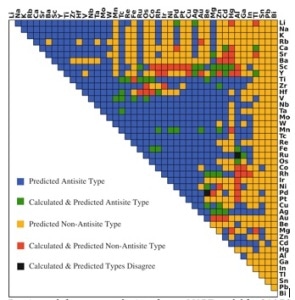Feb 6 2017
 Dominant defect type predictions from r-MART model for 946 B2-type intermetallics. Colors indicate the relationship between prediction and calculations as shown in the legend. (Credit: Bharat Medasan, Berkeley Lab/ PNNL)
Dominant defect type predictions from r-MART model for 946 B2-type intermetallics. Colors indicate the relationship between prediction and calculations as shown in the legend. (Credit: Bharat Medasan, Berkeley Lab/ PNNL)
Machine learning algorithms capable of accurately predicting defect behavior in particular intermetallic compounds have been built for the first time by a team of researchers at the Lawrence Berkeley National Laboratory. This technique will accelerate research of new advanced alloys and new lightweight materials for applications ranging from automotive to aerospace and a lot more.
Their findings can be found in the December 2016 issue of Nature Computational Materials.
Materials can never be structurally flawless and chemically pure. They contain defects most of the time, and these defects play a significant role in dictating properties. The defects may materialize as vacancies, which are essentially ‘holes’ in the crystal structure of a substance, or as antisite defects, which are atoms positioned on the wrong crystal site.
Understanding these types of point defects is vital for researchers developing materials because they can have a striking effect on long-time structural strength and stability.
Traditionally, researchers have used a computational quantum mechanical technique called density functional calculations to predict the kinds of defects that can be formed in a particular structure and how they may impact the material’s properties. Although successful, this method is very computationally expensive to carry out for point defects, restricting the capacity of such investigations.
Density functional calculations work well if you are modeling one small unit, but if you want to make your modeling cell bigger the computational power required to do this increases substantially. And because it is computationally expensive to model defects in a single material, doing this kind of brute force modeling for tens of thousands of materials is not feasible.
Bharat Medasani, Former Postdoc, Berkeley Lab
To conquer these computing hurdles, Medasani and his colleagues designed and trained machine learning algorithms to predict point defects in intermetallic compounds, focusing on the extensively observed B2 crystal structure. To begin with, they chose a sample of 100 of these compounds from the Materials Project Database and performed density functional calculations using supercomputers at the National Energy Research Scientific Computing Center (NERSC), a DOE Office of Science User Facility at Berkeley Lab, to detect their defects.
As they had a small data sample to investigate, Medasani and his team opted for a forest technique referred to as gradient boosting to develop their machine learning technique to a high accuracy. In this technique additional machine learning models were constructed successively and integrated with previous models to reduce the difference between the models predictions and the results produced by density functional calculations.
The researchers carried out the process again and again until they attained a high level of accuracy in their predictions.
This work is essentially a proof of concept. It shows that we can run density functional calculations for a few hundred materials, then train machine learning algorithms to accurately predict point defects for a much larger group of materials.
Bharat Medasani, Former Postdoc, Berkeley Lab
Medasani is currently a postdoctoral researcher at the Pacific Northwest National Laboratory.
“The benefit of this work is now we have a computationally inexpensive machine learning approach that can quickly and accurately predict point defects in new intermetallic materials ” says Andrew Canning, a Berkeley Lab Computational Scientist and co-author on the NPJ paper. “We no longer have to run very costly first principle calculations to identify defect properties for every new metallic compound.”
“This tool enables us to predict metallic defects faster and robustly, which will in turn accelerate materials design,” says Kristin Persson, a Berkeley Lab Scientist and Director of the Materials Project, a program aimed at significantly decreasing the time required to invent new materials by giving open web-based access to computed data on known and predicted materials. As a supplementary part of this research, an open source Python toolkit for modeling point defects in insulators (PyCDT) and semiconductors has been built.
Besides Medasani, Canning and Persson, other authors on the Nature Computational Materials paper include: Hong Ding, Wei Chen, Mark Asta and Maciej Haranczyk (Berkeley Lab); and Anthony Gamst (University of California, San Diego). Additionally, Danny Broberg (University of California, Berkeley), Geoffroy Hautier (University Catholique de Louvain, Belgium) and Nils Zimmermann (Berkeley Lab) were involved in the development of the PyCDT software.
The Department of Energy’s Office of Science supported the research.